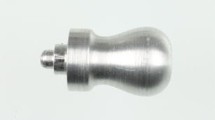Abstract
Medical literature abounds with reports on injuries and fatalities caused by airgun projectiles. While round balls or diabolo pellets have been the standard projectiles for airguns for decades, today, there are a large number of different airgun projectiles available. A very uncommon — and until now unique — discarding sabot airgun projectile (Sussex Sabo Bullet) was introduced into the market in the 1980s. The projectile, available in 0.177 (4.5 mm) and 0.22 (5.5 mm) caliber, consists of a plastic sabot cup surrounding a subcaliber copper-coated lead projectile in typical bullet shape. Following the typical principle of a discarding sabot projectile, the lightweight sabot is supposed to quickly loose velocity and to fall to the ground downrange while the bullet continues on target. These sabot-loaded projectiles are of special forensic interest due to their non-traceability and ballistic parameters. Therefore, it is the aim of this work to investigate the ballistic performance of these sabot airgun projectiles by high-speed video analyses and by measurement of the kinetic parameters of the projectile parts by a transient recording system as well as observing their physical features after being fired. While the sabot principle worked properly in high-energy airguns (E > 17 J), separation of the core projectile from the sabot cup was also observed when discharged in low-energy airguns (E < 7.5 J). While the velocity of the discarded Sussex Sabo core projectile was very close to the velocity of a diabolo-type reference projectile (RWS Meisterkugel), energy density was up to 60 % higher. To conclude, this work is the first study to demonstrate the regular function of this uncommon type of airgun projectile.





Similar content being viewed by others
References
Stankov A, Jakovski Z, Pavlovski G, Muric N, Dwork AJ, Cakar Z (2013) Air gun injury with deadly aftermath – case report. Leg Med (Tokyo) 15:35–37
Bligh-Glover WZ (2012) One-in-a-Million shot. A homicidal thoracic air rifle wound, a case report, and a review of the literature. Am J Forensic Med Pathol 33:98–101
Nili Ahmadabadi M, Karkhaneh R, Kord Valeshabad A, Tabatabai A, Jager MJ, Ahmadabadi EN (2011) Clinical presentation and outcome of perforating ocular injuries due to BB guns: a case series. Injury 42:492–495
Jackson CC, Munyikwa M, Bacha EA, Statter MB, Starr JP (2007) Cardiac BB gun injury with missile embolus to the lung. J Trauma 63:E100–E104
Aslan S, Uzkeser M, Katirci Y, Cakir Z, Bilir O, Bilge F, Cakir M (2006) Air guns: toys or weapons? Am J Forensic Med Pathol 27:260–262
Al-Qattan MM (2006) Air gun pellet injuries of the hand. J Hand Surg (Br) 31B:178–181
Haag MG, Haag LC (1998) The exterior ballistics of contemporary air guns and BB guns. AFTE J 30:262–270
Ziegler M, Weinke H (1973) Umgebautes Luftdruckgewehr als gefährliche Kleinkaliberwaffe. Arch Kriminol 151:109–116
Nedivi L (1997) “More than meets the eye” Weapon alteration: a case report. AFTE J 29:496–497
Caunt R (2003) Dieseling of airguns using commonly available fuels. AFTE J 35:167–173
Jobski O (2012) Schüsse auf Bahn in Rostock. Der Auswerfer 23:149–175
Werner R, Heinecke R (2012) Messtechnische Untersuchungen von Federdruckwaffen. Der Auswerfer 23:349–355
DiMaio VJ, Copeland AR, Besant-Matthews PE, Fletcher LA, Jones A (1982) Minimal velocities necessary for perforation of skin by air gun pellets and bullets. J Forensic Sci 27:894–898
Hallikeri VR, Gouda HS, Kadagoudar SA (2012) Country made scare gun vs. air gun — a comparative study of terminal ballistics using gelatine blocks. Forensic Sci Int 214:148–151
Wightman G, Beard J, Allison R (2010) An investigation into the behaviour of air rifle pellets in ballistic gel and their interaction with bone. Forensic Sci Int 200:41–49
Powley KD, Dahlstrom DB, Atkins VJ, Fackler ML (2004) Velocity necessary for a BB to penetrate the eye. An experimental study using pig eyes. Am J Forensic Med Pathol 25:273–275
Brukner B (2011) Die Luftpistole. dwj-Verlags GmbH, Blaufelden
Bailey JA (2007) .177 caliber pellet classification system and identification key. J Forensic Sci 52:1314–1318
Frank M, Schönekeß H, Jäger F, Herbst J, Ekkernkamp A, Nguyen TT, Bockholdt B (2013) Ballistic parameters of .177 (4.5 mm) caliber plastic-sleeved composite projectiles compared to conventional lead pellets. Int J Legal Med 127:1125–1130
Franke E (1981) Ermittlung der Bewegungsenergie der Geschosse. In: Zobel KF (ed) PTB-Bericht W-19 Gesetzliche Munitionsprüfung. Physikalisch-Technische Bundesanstalt, Braunschweig und Berlin, pp 27–31
Kneubuehl BP, Coupland RM, Rothschild MA, Thali MJ (2011) Wound ballistics, basics and applications. Springer-Verlag, Berlin
Vereinigung der Prüfstellen für angriffshemmende Materialien und Konstruktionen (VPAM) (2012) ARG 2012 Prüfrichtlinie “Materialien und Konstruktionen zur Vermeidung von ab- und rückprallenden Geschossen”. http://www.vpam.eu. Accessed 14 June 2013
Kneubuehl BP (2013) Geschosse, Gesamtausgabe. Ballistik, Messtechnik, Wirksamkeit, Treffsicherheit. Stocker-Schmid, Dietikon
Sellier K (1982) Schußwaffen und Schußwirkungen: I. Ballistik-Medizin-Kriminalistik, Verlag Max Schmidt-Römhild, Lübeck
Kneubuehl BP (1998) Geschosse. Band 1. Ballistik, Treffsicherheit, Wirkungsweise. Verlag Stocker-Schmid, Dietikon-Zürich
Thompson E (1998) Individual characteristics criteria. AFTE J 30:276–278
Sellier K (1977) Schußwaffen und Schußwirkungen: II. Forensische Ballistik, Wundballistik. Verlag Max Schmidt-Römhild, Lübeck
Davis GJ (1993) An atypical shotgun entrance wound caused by a sabot slug. All is not as it seems. Am J Forensic Med Pathol 14:162–164
Frank M, Schönekeß HC, Jäger F, Hertel H, Ekkernkamp A, Bockholdt B (2012) Temporary cavity created by free-flying projectiles propelled from a powder-actuated nail gun. Int J Legal Med 126:801–805
Author information
Authors and Affiliations
Corresponding author
Additional information
In memory of Prof. Dr. rer. nat. Frank Michael Jäger.
Rights and permissions
About this article
Cite this article
Frank, M., Schönekeß, H., Herbst, J. et al. Subcaliber discarding sabot airgun projectiles. Int J Legal Med 128, 303–308 (2014). https://doi.org/10.1007/s00414-013-0944-2
Received:
Accepted:
Published:
Issue Date:
DOI: https://doi.org/10.1007/s00414-013-0944-2




